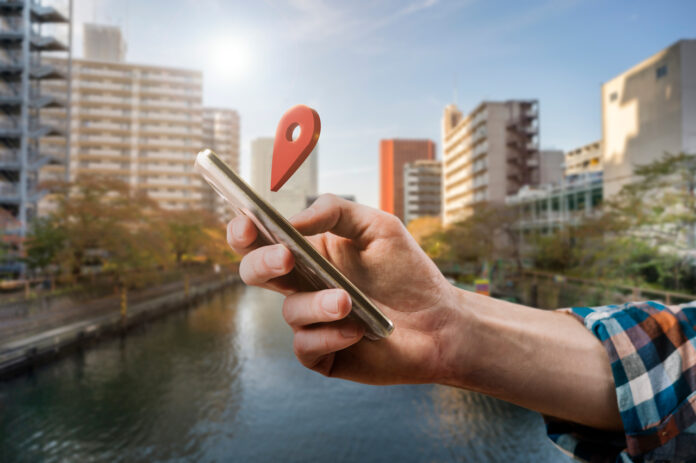A 2022 report revealed the global positioning system (GPS) market revenue recorded $94.25 billion. This figure is projected to increase with a 16.1 percent compound annual growth rate (CAGR) until 2030.
Location-based services lead the market share of this revenue.
Location-based services involve location-aware applications. As the segment continues to dominate the GPS market, it’s good news for developers and new entrants seeking to deploy location-aware apps.
However, location-aware app development is facing significant changes. Navigating the trends and challenges can be challenging, particularly for new entrants.
This guide will help you understand how location-aware applications work. We will also explore the trends shaping the development landscape, challenges, and steps for deploying an app that meets the demand and mitigates the adversaries.
Understanding Location-Aware Applications
Location-aware applications gather and process geolocation data to provide context-aware information and services. These apps leverage users’ real-time geographical positions to deliver personalized content and functionalities.
Here’s how they work:
- Triangulation and Trilateration: The primary methods of determining user location. Triangulation measures angles between devices and known landmarks, while trilateration calculates distances by measuring signal strength from cell towers and satellites.
- Cellular Towers and Satellites: These signal sources transmit a continuous signal stream for devices to calculate. Cell towers also triangulate the signal strength of nearby towers.
- Bluetooth Beacons and Wi-Fi Positioning: GPS signals might be unreliable in indoor and dense environments. In these cases, location-aware apps use Bluetooth beacons and Wi-Fi positioning. Bluetooth beacons emit signals that can determine users’ indoor locations. Meanwhile, Wi-Fi positioning detects users’ proximity to Wi-Fi networks.
- Assisted GPS (A-GPS): This technology enhances the performance of standard GPS through assistance data from nearby cell towers and Wi-Fi networks.
- Sensor Data: Modern smartphones have sensors that provide data about device direction, movement, and orientation. They include accelerometers, magnetometers, and gyroscopes.
Types of location-aware apps
- Mapping and navigation: Mapping and navigation apps like Waze and Google Maps are the most common location-aware apps. They help users plan routes and track locations.
- Fitness and health: Fitness and health apps use location-aware functions to monitor health conditions and track outdoor activities. Examples include heart rate and the number of daily steps.
- Location-based social media: Apps with location-aware features, such as Facebook’s Nearby Friends and dating apps, connect users with people in their vicinity.
- On-demand services: On-demand services like food deliveries and ride-sharing use location-aware functions to let users monitor the status of their orders and rides. Uber, DoorDash, and Uber Eats are some of the popular apps in this segment.
- AR and gaming: AR and gaming apps have location awareness, allowing developers to overlay virtual elements in the real world. These elements encourage users to explore their surroundings and interact with in-game characters.
- Location-based marketing services: Businesses use location-aware marketing apps to create and send targeted promotions and personalized experiences.
Trends Shaping the Location-Aware App Development
The shift in location-aware app development involves the following trends:
Integration with advanced technologies
AR technology
Although this integration has been around for years, the growth of AR technology opens up more possibilities for immersive experiences through location-aware applications. Users can obtain location-based specific information, such as directions and virtual objects around them.
IoT and voice assistants
Users can interact with location-aware applications using voice commands, enabling hands-free navigation. Moreover, location data on IoT devices like wearables and smart sensors helps improve information accuracy and relevance.
Advanced indoor positioning
Developing accurate indoor positioning systems is paramount as people spend significant time indoors.
An example of this advancement in indoor positioning is indoor mapping in airports, hospitals, malls, and other large indoor spaces. Location-aware apps must offer users clear floor plans to help them locate offices, stores, and amenities quickly.
Combining indoor mapping with real-time location tracking, users can receive turn-by-turn directions to find specific amenities and obtain information on nearby promotions.
Additionally, indoor beacons like Bluetooth Low Energy (BLE) are becoming increasingly popular in location-aware apps.
Heightened usage in infrastructure planning, delivery, and logistics
Location-aware applications usage in infrastructure planning, drone delivery, and logistics is experiencing a heightened level of usage for the following reasons:
- Location-aware apps can provide urban planners with location data to identify congested, underutilized, and high-foot-traffic areas. Transportation agencies can also make informed choices based on traffic conditions and commuter movement.
- Location awareness helps improve storage and inventory management, speeding up order fulfillment processes. It can also ensure that products are accurately monitored throughout supply chains.
- With location-aware delivery apps, customers can track the exact locations of their parcels and receive real-time alerts throughout the delivery process.
Challenges in Location-Aware App Development
The challenges developers face when developing location-aware applications include:
Balancing functionality and privacy
Location data is sensitive for many users. They are wary of potential misuse through unauthorized data sharing.
Developers must strive to balance functionality and privacy to ensure confidential information is not compromised.
Essential data privacy practices include:
- Outline a transparent and easily understandable privacy policy
- Collect only the data necessary for the app’s functionality
- Provide users with control over their location data by allowing them to opt in or out of the features
- Regularly audit security protocols to identify and address vulnerabilities
- Adhere to relevant data protection regulations
Addressing battery drain
Continuous or frequent access to GPS can significantly drain devices’ batteries, particularly the power-intensive high-frequency location tracking.
This issue is usually pronounced in applications with real-time navigation and continuous location updates.
Developers must optimize the location tracking functionality to minimize battery consumption while maintaining accuracy and reliability.
This optimization involves less power-hungry tracking methods, reducing location update frequency, or incorporating adaptive algorithms that adjust location tracking intervals based on device activities.
However, these methods can complicate development and compromise accuracy and performance. Different devices and operating systems also handle battery consumption and location services differently, adding another layer of complexity.
Steps for Developing Location-Aware Applications
To develop and deploy a successful location-aware app, follow these practices:
Outline the app objectives and perform market research
The first steps involve outlining your app objectives and performing market research.
With an objective outline, you can determine the primary purpose of the app and its target users. At the same time, market research will help you understand consumer behavior, competitors, and current industry trends.
For instance, you can examine similar apps and determine their strengths and weaknesses. These insights will help you define and ensure your app’s viability in the market.
Market research is also essential to identify unique opportunities that can increase the likelihood of your app’s success. Although location-aware app development has universal trends, finding distinct opportunities is still imperative to stand out.
Choose a suitable map provider and tech stack
Whatever type of location-aware app you choose, the integrations are often similar. It would be best to choose a map provider that can deliver all the required integrations.
Moreover, a tech stack minimizes the need to build an app from scratch. This solution has a set of technologies used to develop, integrate, and run applications.
The technologies include databases, frameworks, programming languages, application programming interfaces (APIs), and front-end and back-end tools.
Design an intuitive user interface
Once you have a map provider and tech stack, design a prototype of your intuitive user interface. You can sketch it on paper or digitally, depending on the testing method.
Your prototype will help you assess whether your concept solution works.
An intuitive user interface is crucial to user experience. This design lets users quickly navigate and access your app features. Ensure that you provide an enjoyable experience that will encourage frequent use.
Integrate the features and security functions
After completing the prototype, integrate the necessary features. These functions may include:
- Notifications for real-time alerts
- Local search features
- Real-time location tracking
- Location sharing
- Location history reports
- Geolocation for real-time device location tracking
- Geofencing to create virtual boundaries that trigger actions when devices enter or exit specific areas
- Geocoding that sets latitude and longitude coordinates for precise locations
- Distance matrix that shows distances and travel time between multiple origins and destinations
- Address autocomplete API that automatically recommends addresses as users type an address
Then, make your location-aware app secure with the following security integrations:
- Two or multi-factor authentications
- Robust encryptions to convert location information into secret codes
Consulting a cybersecurity lawyer is imperative to ensure legal compliance with data privacy standards.
Test for functionality, usability, and performance
Before deployment, thoroughly test your app for functionality, usability, and performance. Whichever testing method you employ will help you identify bugs and fix issues.
Afterward, deploy the app to app stores or your website. Promote it across digital channels to gain traction and users.
Prepare To Scale Up
Location-aware app development is becoming more intricate. Whether your company is an established developer or a new entrant, you must always prepare to scale up to remain adaptive.
As such, anticipating evolving market trends and potential challenges can ensure responsiveness in the dynamic industry. This will help you to meet the demands and mitigate slumps for continuous and sustainable success.







